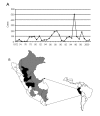Enzootic transmission of yellow fever virus in Peru
- PMID: 12967489
- PMCID: PMC3023271
- DOI: 10.3201/eid0908.030075
Enzootic transmission of yellow fever virus in Peru
Abstract
The prevailing paradigm of yellow fever virus (YFV) ecology in South America is that of wandering epizootics. The virus is believed to move from place to place in epizootic waves involving monkeys and mosquitoes, rather than persistently circulating within particular locales. After a large outbreak of YFV illness in Peru in 1995, we used phylogenetic analyses of virus isolates to reexamine the hypothesis of virus movement. We sequenced a 670-nucleotide fragment of the prM/E gene region from 25 Peruvian YFV samples collected from 1977 to 1999, and delineated six clades representing the states (Departments) of Puno, Pasco, Junin, Ayacucho, San Martin/Huanuco, and Cusco. The concurrent appearance of at least four variants during the 1995 epidemic and the genetic stability of separate virus lineages over time indicate that Peruvian YFV is locally maintained and circulates continuously in discrete foci of enzootic transmission.
Figures




References
-
- Studies on the natural history of yellow fever in Trinidad. Tikasingh ES. Port of Spain, Trinidad & Tobago, Caribbean Epidemiology Center. CAREC monograph Series 1; 1991
-
- Strode GK. Yellow fever. New York: McGraw-Hill; 1951.
-
- Xie H. Mutations in the genome of yellow fever 17D-204 vaccine virus accumulate in the non-structural protein genes. [dissertation]. University of Texas Medical Branch, Galveston, TX; 1997.
Publication types
MeSH terms
Grants and funding
LinkOut - more resources
Full Text Sources
